苏东学派翻译理论
- 格式:pptx
- 大小:1.14 MB
- 文档页数:37

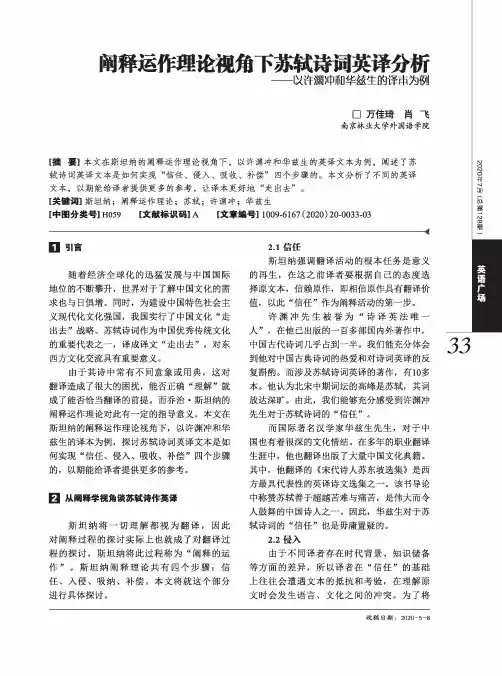
阐轄作理论视角下苏轼诗词英译分析——汉许渊冲和华兹生的译市为例□万佳琦肖飞南京林业大学外国语学院[摘要】本文在斯坦纳的阐释运作理论视角下,以许渊冲和华兹生的英译文本为例,阐述了苏轼诗词英译文本是如何实现“信任、侵入、吸收、补偿”四个步骤的。
本文分析了不同的英译文本,以期能给译者提供更多的参考,让译本更好地“走出去”。
[关键词】斯坦纳;阐释运作理论;苏轼;许渊冲;华兹生[中图分类号1H059[文献标识码]A[文章编号]1009-6167(2020)20-0033-032020曲7F (、亦牆」2 8 S )□引言随着经济全球化的迅猛发展与中国国际地位的不断攀升,世界对于了解中国文化的需求也与日俱增。
同时,为建设中国特色社会主义现代化文化强国,我国实行了中国文化“走出去”战略。
苏轼诗词作为中国优秀传统文化的重要代表之一,译成译文“走出去”,对东西方文化交流具有重要意义。
由于其诗中常有不同意象或用典,这对翻译造成了很大的困扰,能否正确“理解”就成了能否恰当翻译的前提。
而乔治•斯坦纳的阐释运作理论对此有一定的指导意义。
本文在斯坦纳的阐释运作理论视角下,以许渊冲和华兹生的译本为例,探讨苏轼诗词英译文本是如何实现“信任、侵入、吸收、补偿”四个步骤的,以期能给译者提供更多的参考。
Q从阐释学視角谈苏轼诗作英译斯坦纳将一切理解都视为翻译,因此对阐释过程的探讨实际上也就成了对翻译过程的探讨,斯坦纳将此过程称为“阐释的运作”o斯坦纳阐释理论共有四个步骤:信任、入侵、吸纳、补偿。
本文将就这个部分进行具体探讨。
2.1信任斯坦纳强调翻译活动的根本任务是意义的再生,在这之前译者要根据自己的态度选择原文本,信赖原作,即相信原作具有翻译价值,以此“信任”作为阐释活动的第一步。
许渊冲先生被誉为“诗译英法唯一人”,在他已出版的一百多部国内外著作中,中国古代诗词几乎占到一半。
我们能充分体会到他对中国古典诗词的热爱和对诗词英译的反复斟酌。
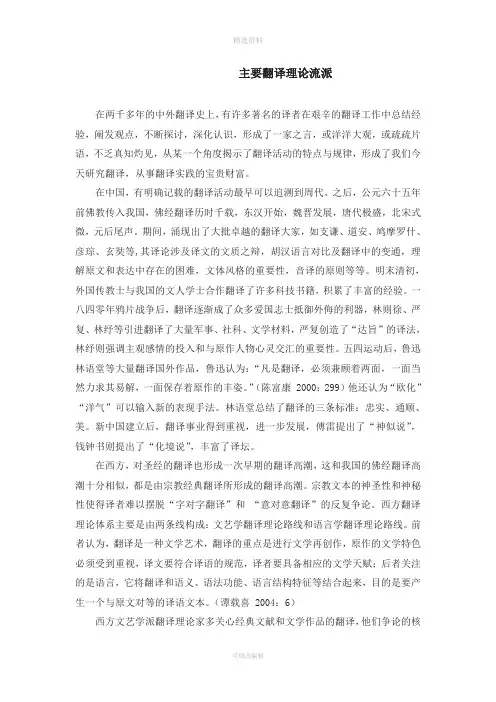
主要翻译理论流派在两千多年的中外翻译史上,有许多著名的译者在艰辛的翻译工作中总结经验,阐发观点,不断探讨,深化认识,形成了一家之言,或洋洋大观,或疏疏片语,不乏真知灼见,从某一个角度揭示了翻译活动的特点与规律,形成了我们今天研究翻译,从事翻译实践的宝贵财富。
在中国,有明确记载的翻译活动最早可以追溯到周代。
之后,公元六十五年前佛教传入我国,佛经翻译历时千载,东汉开始,魏晋发展,唐代极盛,北宋式微,元后尾声。
期间,涌现出了大批卓越的翻译大家,如支谦、道安、鸠摩罗什、彦琮、玄奘等,其译论涉及译文的文质之辩,胡汉语言对比及翻译中的变通,理解原文和表达中存在的困难,文体风格的重要性,音译的原则等等。
明末清初,外国传教士与我国的文人学士合作翻译了许多科技书籍,积累了丰富的经验。
一八四零年鸦片战争后,翻译逐渐成了众多爱国志士抵御外侮的利器,林则徐、严复、林纾等引进翻译了大量军事、社科、文学材料,严复创造了“达旨”的译法,林纾则强调主观感情的投入和与原作人物心灵交汇的重要性。
五四运动后,鲁迅林语堂等大量翻译国外作品,鲁迅认为:“凡是翻译,必须兼顾着两面,一面当然力求其易解,一面保存着原作的丰姿。
”(陈富康2000:299)他还认为“欧化”“洋气”可以输入新的表现手法。
林语堂总结了翻译的三条标准:忠实、通顺、美。
新中国建立后,翻译事业得到重视,进一步发展,傅雷提出了“神似说”,钱钟书则提出了“化境说”,丰富了译坛。
在西方,对圣经的翻译也形成一次早期的翻译高潮,这和我国的佛经翻译高潮十分相似,都是由宗教经典翻译所形成的翻译高潮。
宗教文本的神圣性和神秘性使得译者难以摆脱“字对字翻译”和“意对意翻译”的反复争论。
西方翻译理论体系主要是由两条线构成:文艺学翻译理论路线和语言学翻译理论路线。
前者认为,翻译是一种文学艺术,翻译的重点是进行文学再创作,原作的文学特色必须受到重视,译文要符合译语的规范,译者要具备相应的文学天赋;后者关注的是语言,它将翻译和语义、语法功能、语言结构特征等结合起来,目的是要产生一个与原文对等的译语文本。
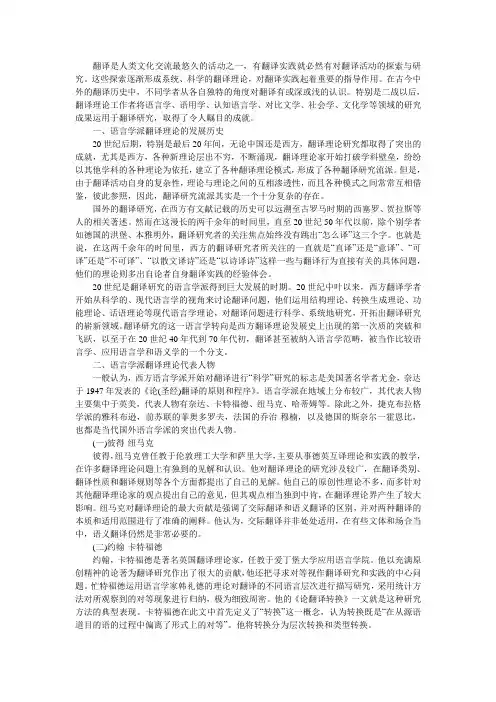
翻译是人类文化交流最悠久的活动之一,有翻译实践就必然有对翻译活动的探索与研究。
这些探索逐渐形成系统、科学的翻译理论,对翻译实践起着重要的指导作用。
在古今中外的翻译历史中,不同学者从各自独特的角度对翻译有或深或浅的认识。
特别是二战以后,翻译理论工作者将语言学、语用学、认知语言学、对比文学、社会学、文化学等领域的研究成果运用于翻译研究,取得了令人瞩目的成就。
一、语言学派翻译理论的发展历史20世纪后期,特别是最后20年间,无论中国还是西方,翻译理论研究都取得了突出的成就,尤其是西方,各种新理论层出不穷,不断涌现,翻译理论家开始打破学科壁垒,纷纷以其他学科的各种理论为依托,建立了各种翻译理论模式,形成了各种翻译研究流派。
但是,由于翻译活动自身的复杂性,理论与理论之间的互相渗透性,而且各种模式之间常常互相借鉴,彼此参照,因此,翻译研究流派其实是一个十分复杂的存在。
国外的翻译研究,在西方有文献记载的历史可以远溯至古罗马时期的西塞罗、贺拉斯等人的相关著述。
然而在这漫长的两千余年的时间里,直至20世纪50年代以前,除个别学者如德国的洪堡、本雅明外,翻译研究者的关注焦点始终没有跳出“怎么译”这三个字。
也就是说,在这两千余年的时间里,西方的翻译研究者所关注的一直就是“直译”还是“意译”、“可译”还是“不可译”、“以散文译诗”还是“以诗译诗”这样一些与翻译行为直接有关的具体问题,他们的理论则多出自论者自身翻译实践的经验体会。
20世纪是翻译研究的语言学派得到巨大发展的时期。
20世纪中叶以来,西方翻译学者开始从科学的、现代语言学的视角来讨论翻译问题,他们运用结构理论、转换生成理论、功能理论、话语理论等现代语言学理论,对翻译问题进行科学、系统地研究,开拓出翻译研究的崭新领域。
翻译研究的这一语言学转向是西方翻译理论发展史上出现的第一次质的突破和飞跃,以至于在20世纪40年代到70年代初,翻译甚至被纳入语言学范畴,被当作比较语言学、应用语言学和语义学的一个分支。
![[当代西方翻译等值理论回顾]当代西方主流的理论](https://uimg.taocdn.com/025622c2cfc789eb162dc83a.webp)
[当代西方翻译等值理论回顾]当代西方主流的理论翻译的等值(equivalence,有人翻译成对等)作为翻译活动的重要标准,“是现代翻译学的核心概念之一。
”在西方,从18世纪英国文艺理论家泰特勒在其著作《翻译原理简论》中提出“等值原则”,到费道罗夫再次关注该理论并于1953年在《翻译理论概要》中提出“作用相符、语言与文本相符”的等值理论,等值理论逐渐受到西方翻译理论家的重视,各理论家也纷纷提出自己对等值的看法,如雅各布森的差异值理论、奈达的动态等值理论等,都大大地发展了等值理论并进而推动了翻译理论的发展。
以下笔者将分4个派别来详述各派对于等值理论的探讨。
一语言学派中对等值理论的探讨较有影响的主要是雅各布森和卡特福德1 雅各布森的等值理论主要有两点:(1)提出“在语际翻译的层面上,一般在符号单元之间没有完全对等。
”此处的符号单元实质上就是单词或词组。
即在不同的语言之间,字与字,词与词是不可能完全对等的。
如英语中“cup”一词在汉语中的对应词是“杯子”,但事实上根据《朗文当代高级英语辞典》中的解释,cup指“a small round container with a handle,that you use to dri nk tea, coffee etc.”而汉语中的“杯子”一词显然不止包含cup,还应包含glass、vessel等容器。
因此,即使是最常用的词也不可能达到完全的对等。
但这并不是说这些语言是不可译的,“种种信息可以对外来的符号单元或信息做出充分解释。
”即可以用目的语的完整信息来解释源语的信息,以达到意义上的等值。
(2)根据雅各布森的观点,还提出“差异等值”的理论。
“意义和对等的问题主要在于语言结构和语言用语中的差异,而不在于强调一种语言能否表述以另一种口头语写成的信息……即跨语言的差异主要集中在一定的语法和辞汇形式。
”这段话表明,首先雅各布森承认语言的可译性,同时跳出了直译和意译的束缚,提出了差异等值。
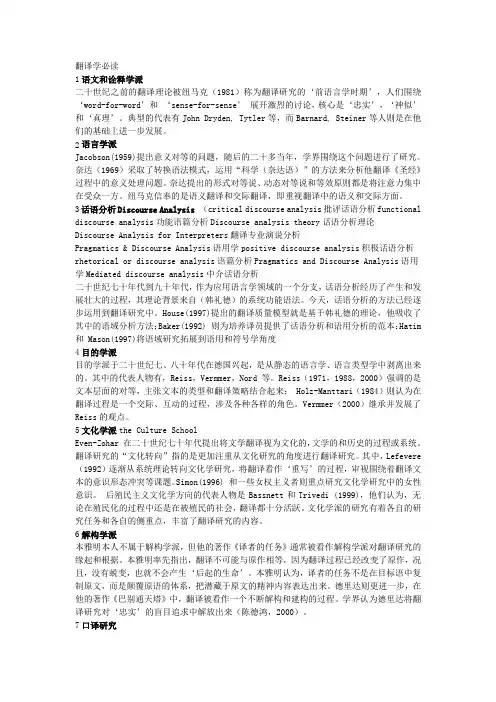
翻译学必读1语文和诠释学派二十世纪之前的翻译理论被纽马克(1981)称为翻译研究的‘前语言学时期’,人们围绕‘word-for-word’和‘sense-for-sense’ 展开激烈的讨论,核心是‘忠实’,‘神似’和‘真理’。
典型的代表有John Dryden, Tytler等,而Barnard, Steiner等人则是在他们的基础上进一步发展。
2语言学派Jacobson(1959)提出意义对等的问题,随后的二十多当年,学界围绕这个问题进行了研究。
奈达(1969)采取了转换语法模式,运用“科学(奈达语)”的方法来分析他翻译《圣经》过程中的意义处理问题。
奈达提出的形式对等说、动态对等说和等效原则都是将注意力集中在受众一方。
纽马克信奉的是语义翻译和交际翻译,即重视翻译中的语义和交际方面。
3话语分析Discourse Analysis(critical discourse analysis批评话语分析functional discourse analysis功能语篇分析Discourse analysis theory话语分析理论Discourse Analysis for Interpreters翻译专业演说分析Pragmatics & Discourse Analysis语用学positive discourse analysis积极话语分析rhetorical or discourse analysis语篇分析Pragmatics and Discourse Analysis语用学Mediated discourse analysis中介话语分析二十世纪七十年代到九十年代,作为应用语言学领域的一个分支,话语分析经历了产生和发展壮大的过程,其理论背景来自(韩礼德)的系统功能语法。
今天,话语分析的方法已经逐步运用到翻译研究中。
House(1997)提出的翻译质量模型就是基于韩礼德的理论,他吸收了其中的语域分析方法;Baker(1992) 则为培养译员提供了话语分析和语用分析的范本;Hatim 和 Mason(1997)将语域研究拓展到语用和符号学角度4目的学派目的学派于二十世纪七、八十年代在德国兴起,是从静态的语言学、语言类型学中剥离出来的。
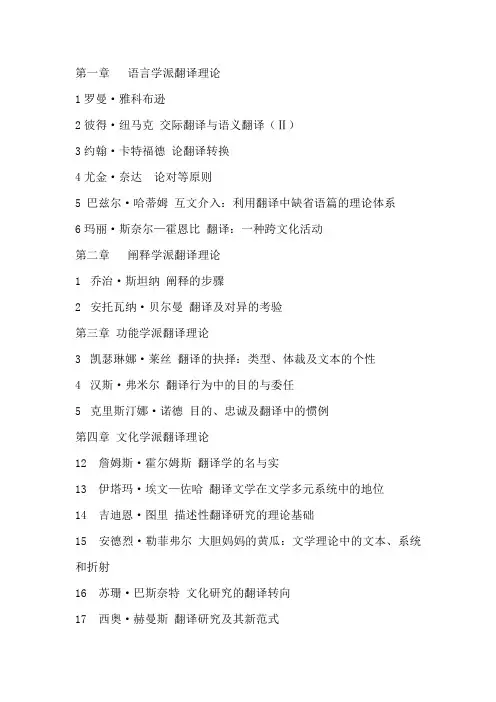
1罗曼·雅科布逊2彼得·纽马克交际翻译与语义翻译(Ⅱ)3约翰·卡特福德论翻译转换4尤金·奈达论对等原则5 巴兹尔·哈蒂姆互文介入:利用翻译中缺省语篇的理论体系6玛丽·斯奈尔—霍恩比翻译:一种跨文化活动第二章阐释学派翻译理论1乔治·斯坦纳阐释的步骤2安托瓦纳·贝尔曼翻译及对异的考验第三章功能学派翻译理论3凯瑟琳娜·莱丝翻译的抉择:类型、体裁及文本的个性4汉斯·弗米尔翻译行为中的目的与委任5克里斯汀娜·诺德目的、忠诚及翻译中的惯例第四章文化学派翻译理论12 詹姆斯·霍尔姆斯翻译学的名与实13 伊塔玛·埃文—佐哈翻译文学在文学多元系统中的地位14 吉迪恩·图里描述性翻译研究的理论基础15 安德烈·勒菲弗尔大胆妈妈的黄瓜:文学理论中的文本、系统和折射16 苏珊·巴斯奈特文化研究的翻译转向17 西奥·赫曼斯翻译研究及其新范式18 瓦尔特·本雅明译者的任务19 雅克·德里达巴别塔之旅20.保罗·德曼评本雅明的《译者的任务》21.劳伦斯·韦努蒂文化身份的塑造第六章女性主义翻译理论22.雪莉·西蒙翻译理论中的性别化立场23.劳丽·钱伯伦性别与翻译的隐喻24.巴巴拉·格达德女性主义话语/翻译的理论化25.冯·弗罗托女性主义翻译理论批评第七章后殖民翻译理论26.道格拉斯·罗宾逊后殖民研究与翻译研究27.特佳斯维妮·尼南贾纳翻译的定位28.盖亚特里·斯皮瓦克翻译的政治29.埃尔斯·维埃拉解放卡利班们——论食人说与哈罗德·德·坎波斯的超越/越界性创造诗学第八章苏东学派翻译理论30.安德烈·费奥多罗夫翻译理论的任务31.吉维·加切奇拉泽文学翻译中的创造性原则32.吉里·列维翻译是一个作选择的过程33.安娜·丽洛娃翻译研究的范畴6Roman Jakobson论翻译的语言学问题“On Linguistic Aspectsof Translation”布拉格语言学派创始人罗曼·雅科布逊1959年发表的《论翻译的语言学问题》首先将语言学、符号学引进了翻译学,他把语言分为“语内翻译(Intralingual Translation)、语际翻译(Interlingual Translation) 和符际翻译(Intersemiotic Translation)”(三分法理论)。
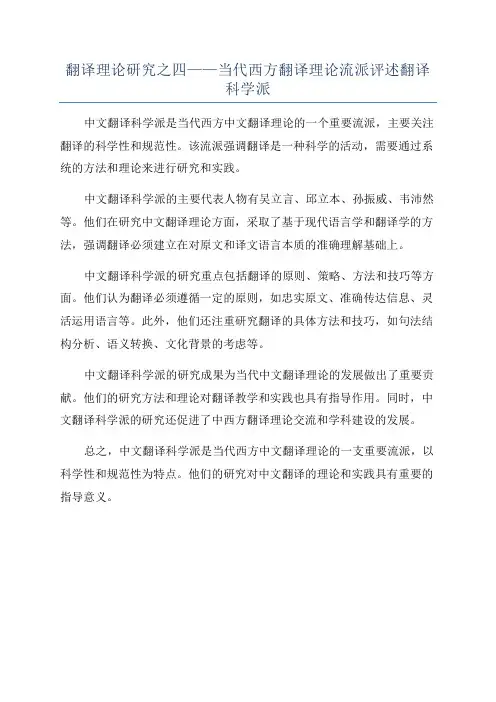
翻译理论研究之四——当代西方翻译理论流派评述翻译
科学派
中文翻译科学派是当代西方中文翻译理论的一个重要流派,主要关注翻译的科学性和规范性。
该流派强调翻译是一种科学的活动,需要通过系统的方法和理论来进行研究和实践。
中文翻译科学派的主要代表人物有吴立言、邱立本、孙振威、韦沛然等。
他们在研究中文翻译理论方面,采取了基于现代语言学和翻译学的方法,强调翻译必须建立在对原文和译文语言本质的准确理解基础上。
中文翻译科学派的研究重点包括翻译的原则、策略、方法和技巧等方面。
他们认为翻译必须遵循一定的原则,如忠实原文、准确传达信息、灵活运用语言等。
此外,他们还注重研究翻译的具体方法和技巧,如句法结构分析、语义转换、文化背景的考虑等。
中文翻译科学派的研究成果为当代中文翻译理论的发展做出了重要贡献。
他们的研究方法和理论对翻译教学和实践也具有指导作用。
同时,中文翻译科学派的研究还促进了中西方翻译理论交流和学科建设的发展。
总之,中文翻译科学派是当代西方中文翻译理论的一支重要流派,以科学性和规范性为特点。
他们的研究对中文翻译的理论和实践具有重要的指导意义。
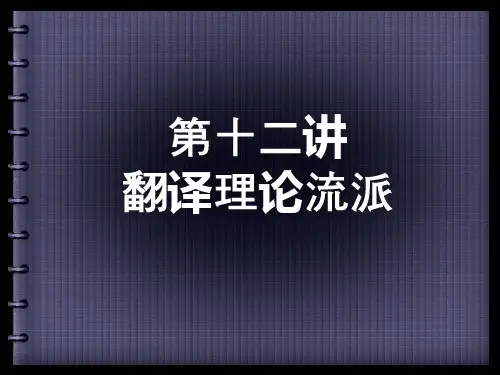
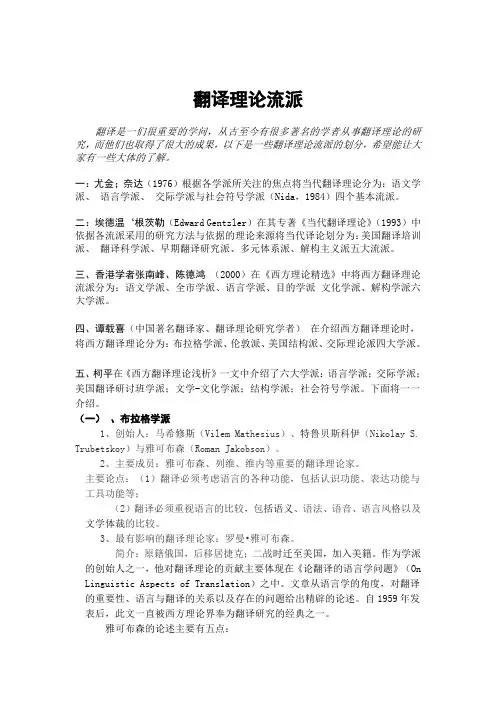
翻译理论流派翻译是一们很重要的学问,从古至今有很多著名的学者从事翻译理论的研究,而他们也取得了很大的成果,以下是一些翻译理论流派的划分,希望能让大家有一些大体的了解。
一:尤金;奈达(1976)根据各学派所关注的焦点将当代翻译理论分为:语文学派、语言学派、交际学派与社会符号学派(Nida,1984)四个基本流派。
二:埃德温‘根茨勒(Edward Gentzler)在其专著《当代翻译理论》(1993)中依据各流派采用的研究方法与依据的理论来源将当代译论划分为:美国翻译培训派、翻译科学派、早期翻译研究派、多元体系派、解构主义派五大流派。
三、香港学者张南峰、陈德鸿(2000)在《西方理论精选》中将西方翻译理论流派分为:语文学派、全市学派、语言学派、目的学派文化学派、解构学派六大学派。
四、谭载喜(中国著名翻译家、翻译理论研究学者)在介绍西方翻译理论时,将西方翻译理论分为:布拉格学派、伦敦派、美国结构派、交际理论派四大学派。
五、柯平在《西方翻译理论浅析》一文中介绍了六大学派:语言学派;交际学派;美国翻译研讨班学派;文学-文化学派;结构学派;社会符号学派。
下面将一一介绍。
(一)、布拉格学派1、创始人:马希修斯(Vilem Mathesius)、特鲁贝斯科伊(Nikolay S. Trubetskoy)与雅可布森(Roman Jakobson)。
2、主要成员:雅可布森、列维、维内等重要的翻译理论家。
主要论点:(1)翻译必须考虑语言的各种功能,包括认识功能、表达功能与工具功能等;(2)翻译必须重视语言的比较,包括语义、语法、语音、语言风格以及文学体裁的比较。
3、最有影响的翻译理论家:罗曼•雅可布森。
简介:原籍俄国,后移居捷克;二战时迁至美国,加入美籍。
作为学派的创始人之一,他对翻译理论的贡献主要体现在《论翻译的语言学问题》(On Linguistic Aspects of Translation)之中。
文章从语言学的角度,对翻译的重要性、语言与翻译的关系以及存在的问题给出精辟的论述。
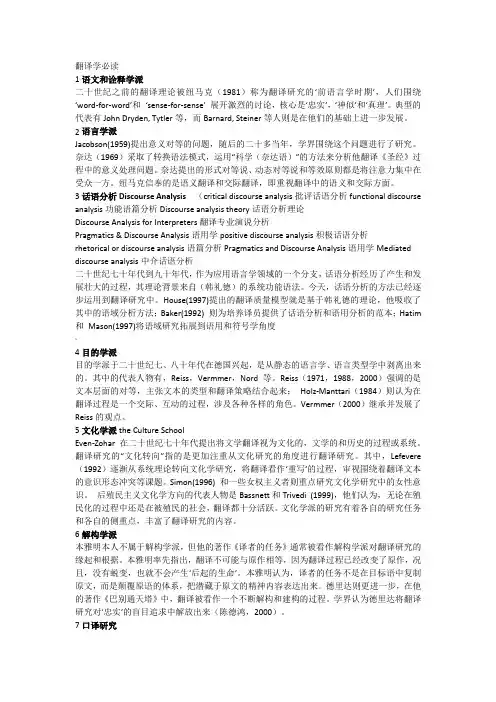
翻译学必读1语文和诠释学派二十世纪之前的翻译理论被纽马克(1981)称为翻译研究的‘前语言学时期’,人们围绕‘word-for-word’和‘sense-for-sense’ 展开激烈的讨论,核心是‘忠实’,‘神似’和‘真理’。
典型的代表有John Dryden, Tytler等,而Barnard, Steiner等人则是在他们的基础上进一步发展。
2语言学派Jacobson(1959)提出意义对等的问题,随后的二十多当年,学界围绕这个问题进行了研究。
奈达(1969)采取了转换语法模式,运用“科学(奈达语)”的方法来分析他翻译《圣经》过程中的意义处理问题。
奈达提出的形式对等说、动态对等说和等效原则都是将注意力集中在受众一方。
纽马克信奉的是语义翻译和交际翻译,即重视翻译中的语义和交际方面。
3话语分析Discourse Analysis(critical discourse analysis批评话语分析functional discourse analysis功能语篇分析Discourse analysis theory话语分析理论Discourse Analysis for Interpreters翻译专业演说分析Pragmatics & Discourse Analysis语用学positive discourse analysis积极话语分析rhetorical or discourse analysis语篇分析Pragmatics and Discourse Analysis语用学Mediated discourse analysis中介话语分析二十世纪七十年代到九十年代,作为应用语言学领域的一个分支,话语分析经历了产生和发展壮大的过程,其理论背景来自(韩礼德)的系统功能语法。
今天,话语分析的方法已经逐步运用到翻译研究中。
House(1997)提出的翻译质量模型就是基于韩礼德的理论,他吸收了其中的语域分析方法;Baker(1992) 则为培养译员提供了话语分析和语用分析的范本;Hatim 和Mason(1997)将语域研究拓展到语用和符号学角度~4目的学派目的学派于二十世纪七、八十年代在德国兴起,是从静态的语言学、语言类型学中剥离出来的。
苏、俄翻译理论语言学派的发展及其研究翻译理论,即在翻译过程中所涉及的理论,其中有的理论是可以直接描述并且可以通过训练习得,而有的理论只能停留在理论层面。
著名的翻译理论有:严复的“信达雅”、 ___娜·诺德的“功能翻译理论(functionali ___)”、尤金·奈达的“功能对等理论(functional equivalen ___)”等著名的翻译理论。
苏、俄的翻译理论在世界的翻译理论中占有十分突出的地位。
1918年高尔基在 ___的支持下创办了世界文学出版社(Издательство《Всемирнаялитература》),任务是介绍世界名著,提高翻译艺术的水平,培养年轻的翻译工 ___。
高尔基把这一重任交给了楚科夫斯基(ЧуковскийК..И.)。
1936年楚科夫斯基有发表了专著《翻译的艺术》(Искусствоперевода),《文艺翻译的原则》也被收录于此,这本专著提出了翻译工 ___必须了解社会环境。
还探讨了原文结构特点和修辞特点的传达问题,以及翻译表达的原则等等。
语言学派最具代表性的人物费奥罗夫,其著作《翻译理论概论》(Введениевтеориюперевода)标志着翻译理论语言学派的诞生,使费奥罗夫成了翻译理论语言学派的奠基人。
翻译语言学的首创者是列茨克尔(Рецкер)在他的专著《谈外译俄中的规律性对应物》(Озакономерныхсоответствияхприпереводенароднойязык)中,他认为,离开语言基础,翻译就无法进行。
指的是原文与译文的对比研究和两种语言间一定的对应物的确立。
这些在词汇、成语、结构和风格上的对应物应构成翻译理论的语言基础。
费奥罗夫发表的《翻译理论概论》(Введениевтеориюперевода)是第一部翻译理论的语言学纲要。
___第一次把翻译理论作为语言学的一个 ___门类提出来,并阐释了翻译理论的研究对象、在语言文学中的地位及其内部结构。
第一次《翻译理论》课作业:Classifications of Schools of TranslationTheories参阅了美国翻译理论家根茨勒的《当代翻译理论》之后,了解到当代西方翻译理论可划分为5大流派,即:TheNorth AmericanTranslation Workshop, The“Sc ience”of Translation,Early TranslationStudies, Polysystem Transla tion, Deconstruction.(1)北美培训学派(TheNorthAmericanTranslation Workshop):侧重实践,强调译文的品味及文学价值,但译论局限于美学经验和指令性翻译规则,缺乏系统化理论。
代表人物有:策德内斯(创立培训班的前提)、理查兹(翻译的理论基础)、庞德(细节翻译理论)、威尔(翻译的矛盾)。
(2)翻译科学学派(The “Science” of Translation):也可称额为翻译的语言学派,其特点就是有加强翻译的理论研究的意识,并想使之称为一门“学科”,但结果又并没有成为一门独立的学科而是成为了别的学科的附属,具体点就是成为语言学的一个分支,所以才有人把这段的翻译研究称为“语言学派”或“科学”学派。
代表人物有:Jakobuson, Nida, J.C.Catford, Wolfram Wills, Newmark,Reiss,Vermeer(3)早期翻译研究派(EarlyTranslation Studies):该学派兴起于70年代的比利时、荷兰等国家,主要探讨译文产生与作用。
该学派主要采取译入文学文化研究手段,侧重直观法和文学翻译,到80年代,该学派学者Jose Lambert转向了译学客观描述个案研究,英国的SusanBassnett, 其著名代表作之一为Translation Stud ies 和比利时学者Andre Lefevere, 其著名代表作之一Translation,Rewriting and the Manipulation of Literary Fame则转向文化研究模式(4)多元体系学派(Polysystem Translation):其翻译理论反战与早期研究学派,是翻译研究学派合乎逻辑的延伸和发展。
当代国外翻译理论导读作者:谢天振编者:谢天振•市场价:¥40.00•卓越价:¥35.20为您节省:4.80元(88折)•VIP 价:¥34.20 SVIP价:¥33.50•全场购物免配送费!•现在有货。
•)目录前言第一章语言学派翻译理论1.罗曼·雅科布逊论翻译的语言学问题2.彼得·纽马克交际翻译与语义翻译(Ⅱ)3.约翰·卡特福德论翻译转换4.尤金·奈达论对等原则5.巴兹尔·哈蒂姆互文介入:利用翻译中缺省语篇的理论体系6.玛丽·斯奈尔—霍恩比翻译:一种跨文化活动第二章阐释学派翻译理论7.乔治·斯坦纳阐释的步骤8.安托瓦纳·贝尔曼翻译及对异的考验第三章功能学派翻译理论9.凯瑟琳娜·莱斯翻译的抉择:类型、体裁及文本的个性10.汉斯·弗米尔翻译行为中的目的与委任11.克里斯汀娜·诺德目的、忠诚及翻译中的惯例第四章文化学派翻译理论12.詹姆斯·霍尔姆斯翻译学的名与实13.伊塔玛·埃文—佐哈翻译文学在文学多元系统中的地位14.吉迪恩·图里描述性翻译研究的理论基础15.安德烈·勒菲弗尔大胆妈妈的黄瓜:文学理论中的文本、系统和折射16.苏珊·巴斯奈特文化研究的翻译转向17.西奥·赫曼斯翻译研究及其新范式第五章解构学派翻译理论18.瓦尔特·本雅明译者的任务19.雅克·德里达巴别塔之旅20.保罗·德曼评本雅明的《译者的任务》21.劳伦斯·韦努蒂文化身份的塑造第六章女性主义翻译理论22.雪莉·西蒙翻译理论中的性别化立场23.劳丽·钱伯伦性别与翻译的隐喻24.巴巴拉·格达德女性主义话语/翻译的理论化25.冯·弗罗托女性主义翻译理论批评第七章后殖民翻译理论26.道格拉斯·罗宾逊后殖民研究与翻译研究27.特佳斯维妮·尼南贾纳翻译的定位28.盖亚特里·斯皮瓦克翻译的政治29.埃尔斯·维埃拉解放卡利班们——论食人说与哈罗德·德·坎波斯的超越/越界性创造诗学第八章苏东学派翻译理论30.安德烈·费奥多罗夫翻译理论的任务31.吉维·加切奇拉泽文学翻译中的创造性原则32.吉里·列维翻译是一个作选择的过程33.安娜·丽洛娃翻译研究的范畴Translation Theory(2007-09-29 14:13:41)标签:学习公社translationenglishtheoryTranslation TheoryBy Juan Daniel Pérez VallejoTranslation teacher,University of Cd. Del Carmen, Campeche, MexicoThe study of proper principle of translation is termed as translation theory. This theory, based on a solid foundation on understanding of how languages work, translation theory recognizes that different languages encode meaning in differing forms, yet guides translators to find appropriate ways of preserving meaning, while using the most appropriate forms of each language. Translation theory includes principles for translating figurative language, dealing with lexical mismatches, rhetorical questions, inclusion of cohesion markers, and many other topics crucial to good translation. Basically there are two competing theories of translation. In one,the predominant purpose is to express as exactly as possible the full force and meaning of everyword and turn of phrase in the original, and in the other the predominant purpose is to produce a result that does not read like a translation at all, but rather moves in its new dress with the same ease as in its native rendering. In the hands of a good translator neither of these two approaches can ever be entirely ignored. Conventionally, it is suggested that in order to perform their job successfully, translators should meet three important requirements; they should be familiar with: the source languagethe target languagethe subject matterBased on this premise, the translator discovers the meaning behind the forms in the source language and does his best to produce the same meaning in the target language - using the forms and structures of the target language. Consequently, what is supposed to change is the form and the code and what should remain unchanged is the meaning and the message. (Larson, 1984)One of the earliest attempts to establish a set of major rules or principles to be referred to in literary translation was made by French translator and humanist Étienne Dolet, who in 1540 f ormulated the following fundamental principles of translation ("La Manière de Bien Traduire d’une Langue en Aultre"), usually regarded as providing rules of thumb for the practicing translator:The translator should understand perfectly the content and intention of the author whom he is translating. The principal way to reach it is reading all the sentences or the text completely so that you can give the idea that you want to say in the target language because the most important characteristic of this technique is translating the message as clearly and natural as possible. If the translation is for different countries besides Mexico, the translator should use the cultural words of that country. For example if he/she has to translate ”She is unloyal with her husband” in this country it can be translated as “Ella le pone los cuernos” but in Peru it can be translated as “Ella le pone los cachos”. In this case it is really important the cultural words because if the translator does not use them correctly the translation will be misunderstood.The translator should have a perfect knowledge of the language from which he is translating and an equally excellent knowledge of the language into which he is translating. At this point the translator must have a wide knowledge in both languages for getting the equivalence in the target language, because the deficiency of the knowledge of both languages will result in a translation without logic and sense. For example if you translate the following sentence “Are you interested in sports?” as “¿Estás interesado en deportes?” the translation is wrong since the idea of this question in English is “¿Practicas algún deporte?”The translator should avoid the tendency to translate word by word, because doing so is to destroy the meaning of the original and to ruin the beauty of the expression_r. This point is very important and one of which if it is translated literally it can transmit another meaning or understanding in the translation.For example in the sentence.- “In this war we have to do or die”, if we translate literally “En esta guerra tenemos que hacer o morir” the message is unclear. The idea is, (.) “En esta guerra tenemos que vencer o morir.”The translator should employ the forms of speech in common usage. The translator should bear in mind the people to whom the translation will be addressed and use words that can be easily understood.Example. “They use a sling to lift the pipes” if the translation is to be read by specialists we would translate it “Utilizan una esling a para levantar la tubería”. If the text is to be read by people who are not specialists we would rather translate it “Utilizan una cadena de suspension para levantar los tubos”.Flip to Text Version La Trobe UniversityHarry AvelingA Short History of Western Translation Theory1. Traditional Translation TheoriesThere is a continuity of intellectual expression from Ancient Greece, Rome, the Middle Ages, through to the Renaissance, the Reformation, and the rise of the early European nation states. The central language of scholars and other readers was Latin, while the core of this tradition was classicalliterature and Judeo-Christianity. There was a profusion of economic and political contacts throughout Europe and the Middle East, and this must have involved an abundance of linguistic transactions. Nevertheless, Lefevere"s words provide an accurate background to understanding the social position of the subjects of traditional translation theory: "In such a culture, translations were not primarily read for information or the mediation of the foreign text. They were produced and read as exercises, first pedagogical exercises, and later on, as exercises in cultural appropriation - in the conscious and controlled usurpation of authority." (Lefevere 1990: 16).2. German RomanticismAt the beginning of the nineteenth century, a second, more philosophical and less empirical, formation began to open within discourses on translation theory (Munday 2001: 27). This formation was connected, in one direction, with the rise of philology as a university discipline, and in another with the literary movement of Romanticism. Philology provided a range of new and exotic texts and allowed the experts to produce translations aimed primarily at other experts, not the general culture of which these scholars were a part (Lefevere 1990: 22). Romanticism exalted the translator "as a creative genius in his own right, in touch with the genius of his original and enriching the literature and language into which he is translating" (Bassnett-McGuire 1980: 65). The stress on both the original author and the translator as being artists was not part of traditional discourse formations.3. The Early and Middle Twentieth CenturyDiscussion in English of translation theory during the first half of the twentieth century continued to be dominated by the themes of Victorian discourse on translation, "literalness, archaizing, pedantry and the production of a text of second-rate literary merit for an elite minority" (Bassnett-McGuire 1980: 73). In his list of major contributors to the area of translation theory, Steiner recognises only the names of Dryden, Quine and Pound among English-speakers. Quine and Pound both belong to the twentieth century and challenged the dominant discourse. Willard V. Quine (b. 1908), a major American philosopher, wrote on "the indeterminacy of translation" within the field of linguistic philosophy (Quine 1960). Ezra Pound (1885-1972) was a poet and critic. Ronnie Apter has argued that Pound made three major innovations to thinking about "the nature and intent of literary translation…he discarded the Victorian pseudo-archaic translation diction; he regarded each translation as a necessarily limited criticism of the original poem; and he regarded good translations as new poems in their own right" (Apter 1987: 3).More radical, and more decisive, developments in translation theory took place in Europe. These begin with the Russian Formalist movement, whichfocused on the "what makes literary texts different from other texts, what makes them new, creative, innovative" (Gentzler 1993: 79). One of their answers was that literary texts rely on a process of "defamiliarisation", using language in new and strikingly different ways from ordinary speech. This led the Formalist to focus on "surface structural features" and "to analyse them to learn what determines literary status" (Gentzler 1993: 79). In so doing, they began the search for descriptive rules, which would help scholars understand the process of translation, and not normative rules, in order to study and assess the work of other translators (Bell 1991: 12). Their work was extended and refined by the Prague school of linguistics, founded by Roman Jakobson, who had earlier worked in Moscow. In his essay "On the Linguistic Aspects of Translation" (1959), Jakobson expanded traditional discourse of "equivalence" into the theme of "equivalence in difference". In so doing, he argued that words should be seen within their (arbitrary) semiotic context, and that "the grammatical pattern of a language (as opposed to its lexical stock) determines those aspects of each experience that must be expressed in the given language" (Venuti 2000: 114).4. Translation StudiesThree factors worked to limit this sharp focus on descriptive linguistics as the major form of discourse on translation. The first was the questioning of Chomsky"s linguistic theories by linguists themselves. The second was the development of a number of new and dynamic fields within linguistics, such as "discourse analysis, text linguistics, sociolinguistics, computational linguistics, prototype semantics, and other assorted wonders" (Pym 1992: 184). These "wonders" took in prior fields such as British social anthropology and American cultural anthropology, as well as contemporary and parallel developments in philosophy, information and communication theories, computational linguistics, machine translation, artificial intelligence, and the ideas of socio-semiotics as developed within French structuralist and post-structuralist thought (Nida 2001: 110). The sense increased that: "Language is not the problem. Ideology and politics are…" (Lefevere 1990: 26). This has led to a separation between linguistic and cultural approaches to translation in the last quarter of the twentieth century. For some translation scholars, indeed, it has seemed that "strictly linguistic theories have been superseded, [as] translation has come to be considered in its cultural, historical and sociological context" (Woodsworth 1998: 100).Basic Knowledge of Translation TheoryI.Translation1.Definition1)The definition in the old daysl“译即易,谓换易言语使相解也。
本文部分内容来自网络整理,本司不为其真实性负责,如有异议或侵权请及时联系,本司将立即删除!== 本文为word格式,下载后可方便编辑和修改! ==阐释学派翻译理论篇一:当代西方主要翻译流派及其理论家《当代国外翻译理论导读》主要翻译流派及学者语言学派翻译理论Roman Jakobson 罗曼·雅科布逊原籍俄罗斯,后移居捷克,最后加入美国国籍Bertrand Russell 柏特兰·罗素Peter Newmark 彼得·纽马克J. C. Catford 约翰·卡特福特,英国Eugene Nida尤金·奈达,美国Basil Hatim巴兹尔·哈蒂姆Mary Snell-Hornby玛丽·斯奈尔—霍恩比阐释学派翻译理论George Steiner乔治·斯坦纳,英国Antoine Berman安托瓦纳·贝尔曼,法国功能学派翻译理论Katharina Reiss 凯瑟琳娜·莱斯,德国Hans Vermeer 汉斯·弗米尔,德国Christiane Nord 克里斯汀娜·诺德,德国文化学派翻译理论James Holmes 詹姆斯·霍尔姆斯Itamar Even-Zohar伊塔玛·埃文—佐哈,以色列Gideon Toury 吉迪恩·图里André Lefevere安德烈·勒菲弗尔Susan Bassnett苏珊·巴斯奈特,英国Theo Hermans西奥·赫曼斯,荷兰解构学派翻译理论Walter Benjamin瓦尔特·本雅明,德国J. Jacques Derrida 雅克·德里达,法国Paul de Man保罗·德曼,美国Lawrence Venuti劳伦斯·韦努蒂,美籍意大利翻译理论家女性主义翻译理论Sherry Simon雪莉·西蒙,加拿大Lori Chamberlain劳丽·钱伯伦Barbara Godard 巴巴拉·格达德,加拿大Luise von Flotow 路易斯·冯·弗罗托后殖民主义翻译理论Douglas Robinson 道格拉斯·罗宾逊,美国Tejaswini Niranjana 特佳斯维妮·尼南贾纳,印度Gayatri Chakravorty Spivak 盖亚特里·斯皮瓦克,印度裔美学 Else Ribeiro Pires Vieira埃尔斯·丽贝罗·皮尔斯·维埃拉,巴西苏东学派翻译理论安德烈·费道罗夫吉维·加切奇拉泽吉里·列维安娜·里洛娃篇二:西方翻译理论西方翻译理论简介中西译论因其不同的哲学思想、价值观念和语言文化习惯形成了彼此相异的译论体系。